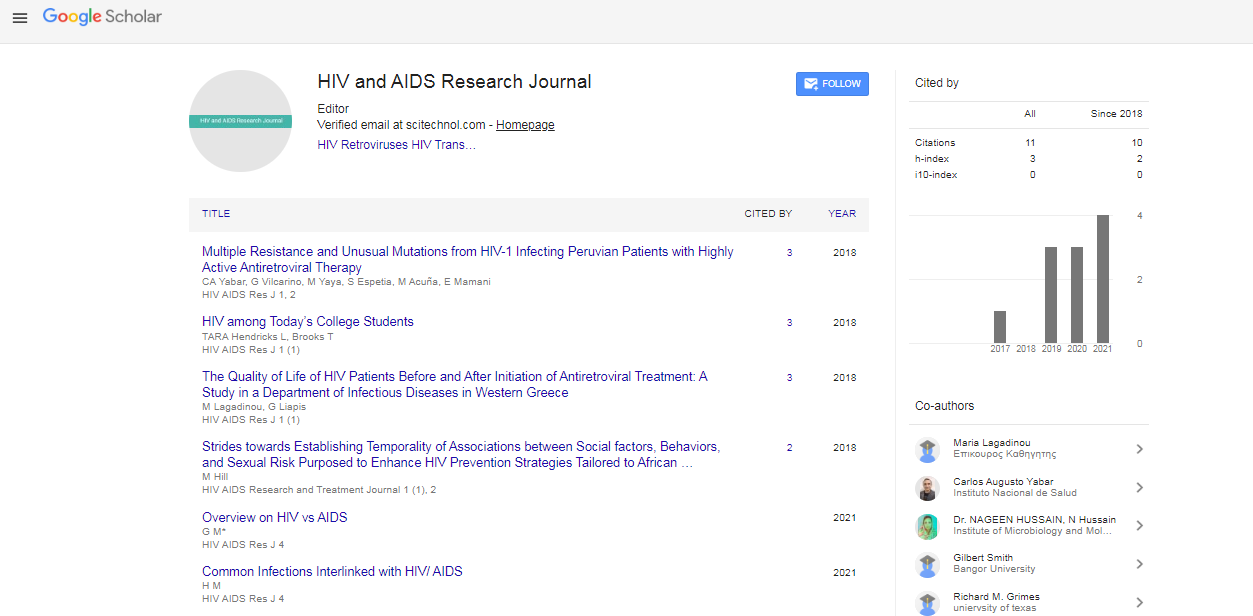Short Communication, Hiv Aids Res J Vol: 6 Issue: 2
Assessing the Molecular Mechanisms and Significance of HIV Retroviruses
Meyer Barbin*
1Department of Neurology, Heinrich-Heine-University, Dusseldorf, Germany
*Corresponding Author: Meyer Barbin,
Department of Neurology, Heinrich-
Heine-University, Düsseldorf, Germany
E-mail: meyer_barbin@hhu11.de
Received date: 23 August, 2023, Manuscript No. HARJ-23-118054;
Editor assigned date: 25 August, 2023, PreQC No. HARJ-23-118054 (PQ);
Reviewed date: 08 September, 2023, QC No. HARJ-23-118054;
Revised date: 15 September, 2023, Manuscript No. HARJ-23-118054 (R);
Published date: 22 September, 2023, DOI: 10.4172/Harj.1000125
Citation: Barbin M (2023) Assessing the Molecular Mechanisms and Significance of HIV Retroviruses. HIV AIDS Res J 6:2.
Description
Human Immunodeficiency Virus (HIV) remains a global health challenge, with millions of people affected worldwide. Understanding the molecular mechanisms and significance of HIV retroviruses is pivotal for advancing knowledge of the virus, improving treatment strategies, and ultimately finding a cure [1]. HIV belongs to the retrovirus family, characterized by its unique mode of replication. The virus possesses a single-stranded RNA genome, which it converts into double-stranded DNA. This conversion is achieved through a series of well-orchestrated steps.
HIV's journey within the host begins with the attachment of its envelope glycoprotein (gp120) to the CD4 receptor and a co-receptor on the surface of host cells, primarily CD4+ T cells and macrophages. Upon attachment, the virus fuses with the cell membrane, releasing its viral core into the host cell's cytoplasm [2]. The viral RNA genome is reverse-transcribed by the enzyme reverse transcriptase into a doublestranded DNA molecule, known as the provirus. This provirus becomes stably integrated into the host cell's genome.
The integrated provirus is now part of the host cell's genetic material. This integration ensures the persistence of the viral genome and allows the virus to evade immune responses. When the host cell becomes activated or stimulated, it transcribes and translates the integrated viral DNA. This leads to the production of new viral RNA and proteins. The newly synthesised viral RNA and proteins assemble at the cell membrane, forming new virions. These virions bud off the host cell, cloaked in a lipid bilayer derived from the host cell membrane, studded with viral envelope glycoproteins [3,4].
Viral protease cleaves the long polyproteins into functional components, leading to the maturation of virions into their infectious form. The molecular mechanisms behind HIV's replication cycle have significant implications for both the virus and the host. The integration of viral DNA into the host genome allows HIV to persist in a latent state, evading the host immune system's surveillance. This is one of the key challenges in developing a cure for HIV. Understanding these mechanisms has allowed researchers to identify numerous drug targets. Antiretroviral Therapy (ART) has been developed to target various stages of the HIV life cycle, providing life-saving treatment for those living with the virus [5,6].
The high mutation rate of HIV during reverse transcription makes the virus prone to developing drug resistance. This underscores the importance of adhering to prescribed drug regimens to prevent resistance [7]. Monitoring viral load through quantifying viral RNA in the blood is a vital component of HIV management. This provides insights into the effectiveness of treatment and the progression of the disease.
Beyond the laboratory, the significance of HIV molecular mechanisms is far-reaching. HIV/AIDS has had a profound socioeconomic and global impact. HIV has been a pandemic for decades. Public health efforts to combat the virus have driven research, funding, and awareness campaigns worldwide [8,9]. The stigma associated with HIV remains a significant barrier to prevention and treatment. Understanding the molecular mechanisms can help dispel myths and reduce stigma. HIV disproportionately affects vulnerable populations and regions with limited access to healthcare. The study of HIV mechanisms is essential to addressing these global health inequities [10].
Conclusion
Assessing the molecular mechanisms and significance of HIV retroviruses is a continuous endeavour with implications that extend far beyond the laboratory. It has not only led to the development of life-saving antiretroviral therapies but has also deepened the understanding of immunoevasion, drug resistance, and global health disparities. As studies continue to uncover the complexities of HIV's inner workings, one can move closer to finding a cure and reducing the global burden of this virus. It is a testament to the power of science inquiry and international collaboration in the face of a formidable global health challenge.
 Spanish
Spanish  Chinese
Chinese  Russian
Russian  German
German  French
French  Japanese
Japanese  Portuguese
Portuguese  Hindi
Hindi 